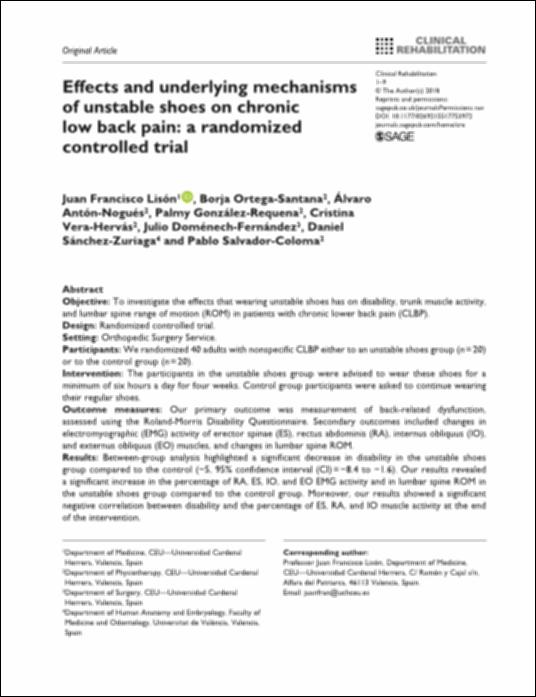Please use this identifier to cite or link to this item:
http://hdl.handle.net/10637/10698Effects and underlying mechanisms of unstable shoes on chronic low back pain : a randomized controlled trial
| Title: | Effects and underlying mechanisms of unstable shoes on chronic low back pain : a randomized controlled trial |
| Authors : | Lisón Párraga, Juan Francisco Ortega Santana, Borja Antón Nogués, Álvaro González Requena, Palmy Vera Hervás, Cristina Doménech Fernández, Julio Sánchez Zuriaga, Daniel Salvador Coloma, Pablo |
| Keywords: | Lumbago - Tratamiento.; Backache - Treatment.; Columna vertebral - Electromiografía.; Chronic pain - Treatment.; Spine - Electromyography.; Dolor crónico - Tratamiento. |
| Publisher: | Sage |
| Citation: | Lisón, JF., Ortega-Santana, B., Antón-Nogués, Á., González-Requena, P., Vera-Hervás, C., Doménech-Fernández, J. et al. (2018). Effects and underlying mechanisms of unstable shoes on chronic low back pain : a randomized controlled trial. Clinical Rehabilitationol. 32, n. 5 (may), pp. 654-662. DOI: https://doi.org/10.1177/0269215517753972 |
| Abstract: | Objective: To investigate the effects that wearing unstable shoes has on disability, trunk muscle activity, and lumbar spine range of motion (ROM) in patients with chronic lower back pain (CLBP). Design: Randomized controlled trial. Setting: Orthopedic Surgery Service. Participants: We randomized 40 adults with nonspecific CLBP either to an unstable shoes group (n = 20) or to the control group (n = 20). Intervention: The participants in the unstable shoes group were advised to wear these shoes for a minimum of six hours a day for four weeks. Control group participants were asked to continue wearing their regular shoes. Outcome measures: Our primary outcome was measurement of back-related dysfunction, assessed using the Roland-Morris Disability Questionnaire. Secondary outcomes included changes in electromyographic (EMG) activity of erector spinae (ES), rectus abdominis (RA), internus obliquus (IO), and externus obliquus (EO) muscles, and changes in lumbar spine ROM. Results: Between-group analysis highlighted a significant decrease in disability in the unstable shoes group compared to the control (−5, 95% confidence interval (CI) = −8.4 to −1.6). Our results revealed a significant increase in the percentage of RA, ES, IO, and EO EMG activity and in lumbar spine ROM in the unstable shoes group compared to the control group. Moreover, our results showed a significant negative correlation between disability and the percentage of ES, RA, and IO muscle activity at the end of the intervention. |
| Description: | Este artículo se encuentra disponible en la página web de la revista en la siguiente URL: https://journals.sagepub.com/doi/abs/10.1177/0269215517753972?rfr_dat=cr_pub%3Dpubmed&url_ver=Z39.88-2003&rfr_id=ori%3Arid%3Acrossref.org&journalCode=crea Este es el postprint del siguiente artículo: Lisón, JF., Ortega-Santana, B., Antón-Nogués, Á., González-Requena, P., Vera-Hervás, C., Doménech-Fernández, J. et al. (2018). Effects and underlying mechanisms of unstable shoes on chronic low back pain : a randomized controlled trial. Clinical Rehabilitationol. 32, n. 5 (may), pp. 654-662, que se ha publicado de forma definitiva en https://doi.org/10.1177/0269215517753972 This is the pre-peer reviewed version of the following article: Lisón, JF., Ortega-Santana, B., Antón-Nogués, Á., González-Requena, P., Vera-Hervás, C., Doménech-Fernández, J. et al. (2018). Effects and underlying mechanisms of unstable shoes on chronic low back pain : a randomized controlled trial. Clinical Rehabilitationol. 32, n. 5 (may), pp. 654-662, which has been published in final form at https://doi.org/10.1177/0269215517753972 |
| URI: | http://hdl.handle.net/10637/10698 |
| Rights : | http://creativecommons.org/licenses/by-nc-nd/4.0/deed.es |
| ISSN: | 0269-2155 1477-0873 (Electrónico) |
| Issue Date: | 20-May-2018 |
| Center : | Universidad Cardenal Herrera-CEU |
| Appears in Collections: | Dpto. Medicina y Cirugía |
Items in DSpace are protected by copyright, with all rights reserved, unless otherwise indicated.


